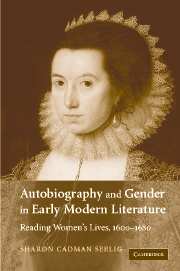Book contents
- Frontmatter
- Contents
- Preface
- Introduction: mapping the territory
- 1 Margaret Hoby: the stewardship of time
- 2 The construction of a life: the diaries of Anne Clifford
- 3 Pygmalion's image: the lives of Lucy Hutchinson
- 4 Ann Fanshawe: private historian
- 5 Romance and respectability: the autobiography of Anne Halkett
- 6 Margaret Cavendish: shy person to Blazing Empress
- Conclusion: “The Life of Me”
- Notes
- Bibliography
- Index
4 - Ann Fanshawe: private historian
Published online by Cambridge University Press: 22 September 2009
- Frontmatter
- Contents
- Preface
- Introduction: mapping the territory
- 1 Margaret Hoby: the stewardship of time
- 2 The construction of a life: the diaries of Anne Clifford
- 3 Pygmalion's image: the lives of Lucy Hutchinson
- 4 Ann Fanshawe: private historian
- 5 Romance and respectability: the autobiography of Anne Halkett
- 6 Margaret Cavendish: shy person to Blazing Empress
- Conclusion: “The Life of Me”
- Notes
- Bibliography
- Index
Summary
Like Lucy Hutchinson and Margaret Cavendish, who wrote full-length biographies of their husbands, Ann Fanshawe constructs an account that focuses on the achievements of Sir Richard Fanshawe, and on their material and symbolic vicissitudes and successes. Writing to her son Richard (the only surviving male child), Ann Fanshawe promises “the most remarkable actions and accidents of your family, as well as those of more eminent ones of your father and my life.” As family historian, Fanshawe adopts one of the forms acceptable to women of her time, and so commits herself to a purpose that helps shape her presentation. Untitled, and not intended for publication, the text was copied by an amanuensis, corrected, and handsomely bound with “red leather, gilt tooled, in the centre of both covers a device of arms, Fanshawe impaling Harrison.”
Ann Harrison Fanshawe, the daughter of John Harrison and his wife Margaret, was born in 1625. She met her future husband Richard Fanshawe at Oxford, where he, like her father, had gone to support King Charles; the two were married in 1644, shortly after Fanshawe was appointed Secretary for War to the Prince of Wales; he was thirty-six; she was nineteen. Their life thereafter was a series of extensive travels and adventures caused by the Civil War and their loyalty to the King. In twenty years Ann Fanshawe bore six sons and eight daughters, only five of whom survived infancy.
- Type
- Chapter
- Information
- Autobiography and Gender in Early Modern LiteratureReading Women's Lives, 1600–1680, pp. 90 - 109Publisher: Cambridge University PressPrint publication year: 2006
- 1
- Cited by



